Study on Dynamic Probability and Quantitative Risk Calculation Method of Domino Accident in Pool Fire in Chemical Storage Tank Area
Abstract
:1. Introduction
2. Methodology
2.1. Collecting Basic Data
2.2. Calculating the Vulnerability Parameters of the Target Storage Tank
2.3. Determining the Next Failed Tank by Monte Carlo Simulation
2.4. Calculating the Equivalent Heat Radiation Flux of the Remaining Target Units
2.5. Calculating the Vulnerability Parameters of Remaining Target Units under the Space–Time Synergistic Effect
2.6. Determining the Sequence of Failure Storage Tanks under the Space–Time Synergy Effect
2.7. Quantitative Area Risk Analysis
3. Case Study
- It was assumed that tank A caught fire first;
- Only thermal radiation was considered, and only pool fire was assumed as an accident scenario;
- Regardless of the development time of the fire, the temperature of the fire was considered to be average.
4. Results and Discussion
5. Conclusions
Author Contributions
Funding
Institutional Review Board Statement
Informed Consent Statement
Conflicts of Interest
Appendix A
| Extent of Damage | Radiation Intensity (kW/m2) | Result |
|---|---|---|
| Death radius | 10 | 60 s may cause death |
| Radius of serious injury | 6.6 | 60 s will cause second degree burns |
| Radius of minor injury | 3 | 60 s will cause first degree burns |
References
- Kim, J.; Jo, H.C.; Oh, S.; Lee, S.; Lee, K.; Lim, Y.M. Development of rapid construction technology for liquified natural gas storage tanks using precast concrete panels as a permanent form. Pci. J. 2019, 64, 62–79. [Google Scholar] [CrossRef]
- Pang, L.; Hu, Q.; Yang, K. Numerical study of external explosion characteristics induced by indoor natural gas vented explosion. Int. J. Numer. Methods Heat Fluid Flow 2022, 32, 404–431. [Google Scholar] [CrossRef]
- Yang, K.; Hu, Q.; Sun, S.; Lv, P.; Pang, L. Research progress on multi-overpressure peak structures of vented gas explosions in confined spaces. J. Loss Prev. Proc. 2019, 62, 103969. [Google Scholar] [CrossRef]
- Lee, H.E.; Yoon, S.J.; Sohn, J.R.; Huh, D.A.; Lee, B.W.; Moon, K.W. Flammable Substances in Korea Considering the Domino Effect: Assessment of Safety Distance. Int. J. Environ. Res. Public Health 2019, 16, 969. [Google Scholar] [CrossRef] [PubMed] [Green Version]
- Espinosa, S.N.; Jaca, R.C.; Godoy, L.A. Thermal effects of fire on a nearby fuel storage tank. J. Loss Prev. Proc. 2019, 62, 103990. [Google Scholar] [CrossRef]
- Jaca, R.C.; Godoy, L.A.; Calabro, H.D.; Espinosa, S.N. Thermal post-buckling behavior of oil storage tanks under a nearby fire. Int. J. Pres. Ves. Pip. 2021, 189, 104289. [Google Scholar] [CrossRef]
- Ding, Y.; Lu, Y.; Chen, Z. Study on the Influence of Frangible Roof Performance of Tank Explosion Under Multi-field Coupling. J. Fail Anal. Prev. 2019, 19, 1455–1463. [Google Scholar] [CrossRef]
- Liu, H.; Jiang, J.; Li, Y.; Ni, L.; Wang, J. Coupling effects of the explosion shock wave and heat radiation on the dynamic response of a fixed-roof tank. J. Loss Prev. Proc. 2021, 72, 104534. [Google Scholar] [CrossRef]
- Li, Y.H.; Jiang, J.C.; Yu, Y.; Wang, Z.R.; Xing, Z.X.; Zhang, Q.W. Fire resistance of a vertical oil tank exposed to pool-fire heat radiation after high-velocity projectile impact. Process Saf. Environ. 2021, 156, 231–243. [Google Scholar] [CrossRef]
- He, Z.C.; Weng, W.G. Synergic effects in the assessment of multi-hazard coupling disasters: Fires, explosions, and toxicant leaks. J. Hazard Mater. 2020, 388, 121813. [Google Scholar] [CrossRef]
- Darbra, R.M.; Palacios, A.; Casal, J. Domino effect in chemical accidents: Main features and accident sequences. J. Hazard Mater. 2010, 183, 565–573. [Google Scholar] [CrossRef] [PubMed]
- Abdolhamidzadeh, B.; Abbasi, T.; Rashtchian, D.; Abbasi, S.A. Domino effect in process-industry accidents—An inventory of past events and identification of some patterns. J. Loss Prev. Proc. 2011, 24, 575–593. [Google Scholar] [CrossRef]
- Ronza, A.; Félez, S.; Darbra, R.M.; Carol, S.; Vílchez, J.A.; Casal, J. Predicting the frequency of accidents in port areas by developing event trees from historical analysis. J. Loss Prev. Proc. 2003, 16, 551–560. [Google Scholar] [CrossRef]
- Broeckmann, B.; Schecker, H. Heat transfer mechanisms and boilover in burning oil-water systems. J. Loss Prev. Proc. 1995, 8, 137–147. [Google Scholar] [CrossRef]
- Ferrero, F.; Muñoz, M.; Kozanoglu, B.; Casal, J.; Arnaldos, J. Experimental study of thin-layer boilover in large-scale pool fires. J. Hazard Mater. 2006, 137, 1293–1302. [Google Scholar] [CrossRef] [PubMed]
- Kong, D.; Zhao, X.; Chen, J.; Yang, H.; Du, J. Study on hazard characteristics and safety distance of small-scale boilover fire. Int. J. Therm. Sci. 2021, 164, 106888. [Google Scholar] [CrossRef]
- Mealy, C.; Benfer, M.; Gottuk, D. Liquid Fuel Spill Fire Dynamics. Fire Technol. 2014, 50, 419–436. [Google Scholar] [CrossRef]
- Liu, J.; Li, D.; Wang, Z.; Chai, X. A state-of-the-art research progress and prospect of liquid fuel spill fires. Case Stud. Therm. Eng. 2021, 28, 101421. [Google Scholar] [CrossRef]
- Li, Y.; Jiang, J.; Zhang, Q.; Yu, Y.; Wang, Z.; Liu, H.; Shu, C. Static and dynamic flame model effects on thermal buckling: Fixed-roof tanks adjacent to an ethanol pool-fire. Process Saf. Environ. 2019, 127, 23–35. [Google Scholar] [CrossRef]
- Wang, W.; Xu, Z.; Sun, B. Numerical Simulation of Fire Thermal Radiation Field for Large Crude Oil Tank Exposed to Pool Fire. Procedia Eng. 2013, 52, 395–400. [Google Scholar] [CrossRef]
- Tauseef, S.M.; Abbasi, T.; Pompapathi, V.; Abbasi, S.A. Case studies of 28 major accidents of fires/explosions in storage tank farms in the backdrop of available codes/standards/models for safely configuring such tank farms. Process Saf. Environ. 2018, 120, 331–338. [Google Scholar] [CrossRef]
- Hou, L.; Wu, X.; Wu, Z.; Wu, S. Pattern identification and risk prediction of domino effect based on data mining methods for accidents occurred in the tank farm. Reliab. Eng. Syst. Safe 2020, 193, 106646. [Google Scholar] [CrossRef]
- Alileche, N.; Cozzani, V.; Reniers, G.; Estel, L. Thresholds for domino effects and safety distances in the process industry: A review of approaches and regulations. Reliab. Eng. Syst. Safe 2015, 143, 74–84. [Google Scholar] [CrossRef]
- Ahmadi, O.; Mortazavi, S.B.; Pasdarshahri, H.; Mohabadi, H.A. Consequence analysis of large-scale pool fire in oil storage terminal based on computational fluid dynamic (CFD). Process Saf. Environ. 2019, 123, 379–389. [Google Scholar] [CrossRef]
- Pourkeramat, A.; Daneshmehr, A.; Jalili, S.; Aminfar, K. Investigation of wind and smoke concentration effects on thermal instability of cylindrical tanks with fixed roof subjected to an adjacent fire. Thin Wall Struct. 2021, 160, 107384. [Google Scholar] [CrossRef]
- Scarponi, G.E.; Landucci, G.; Birk, A.M.; Cozzani, V. An innovative three-dimensional approach for the simulation of pressure vessels exposed to fire. J. Loss Prev. Proc. 2019, 61, 160–173. [Google Scholar] [CrossRef]
- Scarponi, G.E.; Landucci, G.; Birk, A.M.; Cozzani, V. Three dimensional CFD simulation of LPG tanks exposed to partially engulfing pool fires. Process Saf. Environ. 2021, 150, 385–399. [Google Scholar] [CrossRef]
- Santana, J.; Orozco, J.L.; Lantigua, D.F.; Furka, D.; Furka, S.; Cruz, A.G. Using integrated Bayesian-Petri Net method for individual impact assessment of domino effect accidents. J. Clean Prod. 2021, 294, 126236. [Google Scholar] [CrossRef]
- Jiang, D.; Pan, X.H.; Hua, M.; Mebarki, A.; Jiang, J.C. Assessment of tanks vulnerability and domino effect analysis in chemical storage plants. J. Loss Prev. Proc. 2019, 60, 174–182. [Google Scholar] [CrossRef]
- Ahn, M.S.; Lee, H.E.; Cheon, K.S.; Joo, H.G.; Son, B.S. Feasibility Evaluation of Designated Quantities for Chemicals Requiring Preparation for Accidents in the Korean Chemical Accident Prevention System. Int. J. Environ. Res. Public Health 2020, 17, 1927. [Google Scholar] [CrossRef]
- Huh, D.A.; Huh, E.H.; Byeon, S.H.; Sohn, J.R.; Moon, K.W. Development of Accident Probability Index Using Surrogate Indicators of Chemical Accidents in Chemical Plants. Int. J. Environ. Res. Public Health 2019, 16, 3271. [Google Scholar] [CrossRef] [PubMed] [Green Version]
- Li, X.; Chen, G.; Huang, K.; Zeng, T.; Zhang, X.; Yang, P.; Xie, M. Consequence modeling and domino effects analysis of synergistic effect for pool fires based on computational fluid dynamic. Process Saf. Environ. 2021, 156, 340–360. [Google Scholar] [CrossRef]
- Wu, D.Y.; Chen, Z. Quantitative risk assessment of fire accidents of large-scale oil tanks triggered by lightning. Eng. Fail Anal. 2016, 63, 172–181. [Google Scholar] [CrossRef]
- Hou, S.; Luan, X.; Wang, Z.; Cozzani, V.; Zhang, B. A quantitative risk assessment framework for domino accidents caused by double pool fires. J. Loss Prev. Proc. 2022, 79, 104843. [Google Scholar] [CrossRef]
- Sarvestani, K.; Ahmadi, O.; Mortazavi, S.B.; Mahabadi, H.A. Development of a predictive accident model for dynamic risk assessment of propane storage tanks. Process Saf. Environ. 2021, 148, 1217–1232. [Google Scholar] [CrossRef]
- Shou, Y.; Chen, J.; Guo, X.; Zhu, J.; Ding, L.; Ji, J.; Cheng, Y. A dynamic individual risk management method considering spatial and temporal synergistic effect of toxic substance leakage and fire accidents. Process Saf. Environ. 2023, 169, 238–251. [Google Scholar] [CrossRef]
- Chen, C.; Reniers, G.; Zhang, L.B. An innovative methodology for quickly modeling the spatial-temporal evolution of domino accidents triggered by fire. J. Loss Prev. Proc. 2018, 54, 312–324. [Google Scholar] [CrossRef]
- Zhou, J.; Reniers, G.; Cozzani, V. Improved probit models to assess equipment failure caused by domino effect accounting for dynamic and synergistic effects of multiple fires. Process Saf. Environ. 2021, 154, 306–314. [Google Scholar] [CrossRef]
- Zhang, L.B.; Landucci, G.; Reniers, G.; Khakzad, N.; Zhou, J.F. DAMS: A Model to Assess Domino Effects by Using Agent-Based Modeling and Simulation. Risk Anal. 2018, 38, 1585–1600. [Google Scholar] [CrossRef]
- Ovidi, F.; Zhang, L.B.; Landucci, G.; Reniers, G. Agent-based model and simulation of mitigated domino scenarios in chemical tank farms. Reliab. Eng. Syst. Safe 2021, 209, 107476. [Google Scholar] [CrossRef]
- Ding, L.; Khan, F.; Abbassi, R.; Ji, J. FSEM: An approach to model contribution of synergistic effect of fires for domino effects. Reliab. Eng. Syst. Safe 2019, 189, 271–278. [Google Scholar] [CrossRef]
- Ding, L.; Khan, F.; Ji, J. A novel approach for domino effects modeling and risk analysis based on synergistic effect and accident evidence. Reliab. Eng. Syst. Safe 2020, 203, 107109. [Google Scholar] [CrossRef]
- Ding, L.; Khan, F.; Ji, J. A novel vulnerability model considering synergistic effect of fire and overpressure in chemical processing facilities. Reliab. Eng. Syst. Safe 2022, 217, 108081. [Google Scholar] [CrossRef]
- Cozzani, V.; Gubinelli, G.; Antonioni, G.; Spadoni, G.; Zanelli, S. The assessment of risk caused by domino effect in quantitative area risk analysis. J. Hazard Mater. 2005, 127, 14–30. [Google Scholar] [CrossRef]
- Landucci, G.; Gubinelli, G.; Antonioni, G.; Cozzani, V. The assessment of the damage probability of storage tanks in domino events triggered by fire. Accid. Anal. Prev. 2009, 41, 1206–1215. [Google Scholar] [CrossRef] [PubMed]
- He, Z.C.; Weng, W.G. A dynamic and simulation-based method for quantitative risk assessment of the domino accident in chemical industry. Process Saf. Environ. 2020, 144, 79–92. [Google Scholar] [CrossRef]
- Wu, S.Z.; Hou, L.; Wu, X.G.; Liu, F.Y. Influence of safety barriers on probability of domino effect triggerred by pool fire in tank farm. Oil Gas Storage Transp. 2022, 41, 165–176. [Google Scholar]
- Pasman, H.; Reniers, G. Past, present and future of Quantitative Risk Assessment (QRA) and the incentive it obtained from Land-Use Planning (LUP). J. Loss Prev. Proc. 2014, 28, 2–9. [Google Scholar] [CrossRef]
- Steijn, W.; Van Kampen, J.N.; Van der Beek, D.; Groeneweg, J.; Van Gelder, P. An integration of human factors into quantitative risk analysis using Bayesian Belief Networks towards developing a ‘QRA plus’. Safety Sci. 2020, 122, 104514. [Google Scholar] [CrossRef]
- Baesi, S.; Abdolhamidzadeh, B.; Hassan, C.; Hamid, M.D.; Reniers, G. Application of a multi-plant QRA: A case study investigating the risk impact of the construction of a new plant on an existing chemical plant’s risk levels. J. Loss Prev. Proc. 2013, 26, 895–903. [Google Scholar] [CrossRef]
- Kim, H.; Heo, G.; Jung, S. QRA considering multi-vessel failure scenarios due to a natural disaster—Lessons from Fukushima. J. Loss Prev. Proc. 2016, 44, 699–705. [Google Scholar] [CrossRef]
- Suzuki, T.; Kawatsu, K.; Shiota, K.; Izato, Y.; Komori, M.; Sato, K.; Takai, Y.; Ninomiya, T.; Miyake, A. Quantitative risk assessment of a hydrogen refueling station by using a dynamic physical model based on multi-physics system-level modeling. Int. J. Hydrogen. Energ. 2021, 46, 38923–38933. [Google Scholar] [CrossRef]
- Pietersen, C.M. Consequences of accidental releases of hazardous material. J. Loss Prev. Process Ind. 1990, 3, 136–141. [Google Scholar] [CrossRef]
- Pietersen, C.M. Analysis of the LPG disaster in Mexico City. J. Hazard Mater. 1988, 20, 85–107. [Google Scholar] [CrossRef]
- Cheng, Y.L.; Luo, Y.; Shi, L.C.; Xu, M. Quantitative assessment of Na-Tech risk in chemical industry park. Chem. Ind. Eng. Prog. 2019, 38, 283–287. [Google Scholar]
- GB/T 37243—2019; Determination Method of External Safety Distance for Hazardous Chemicals Production Units and Storage Installations. Administration for Market Regulation Inspection, Quarantine of the People’s Republic of China; Standards Press of China: Beijing, China, 2019.
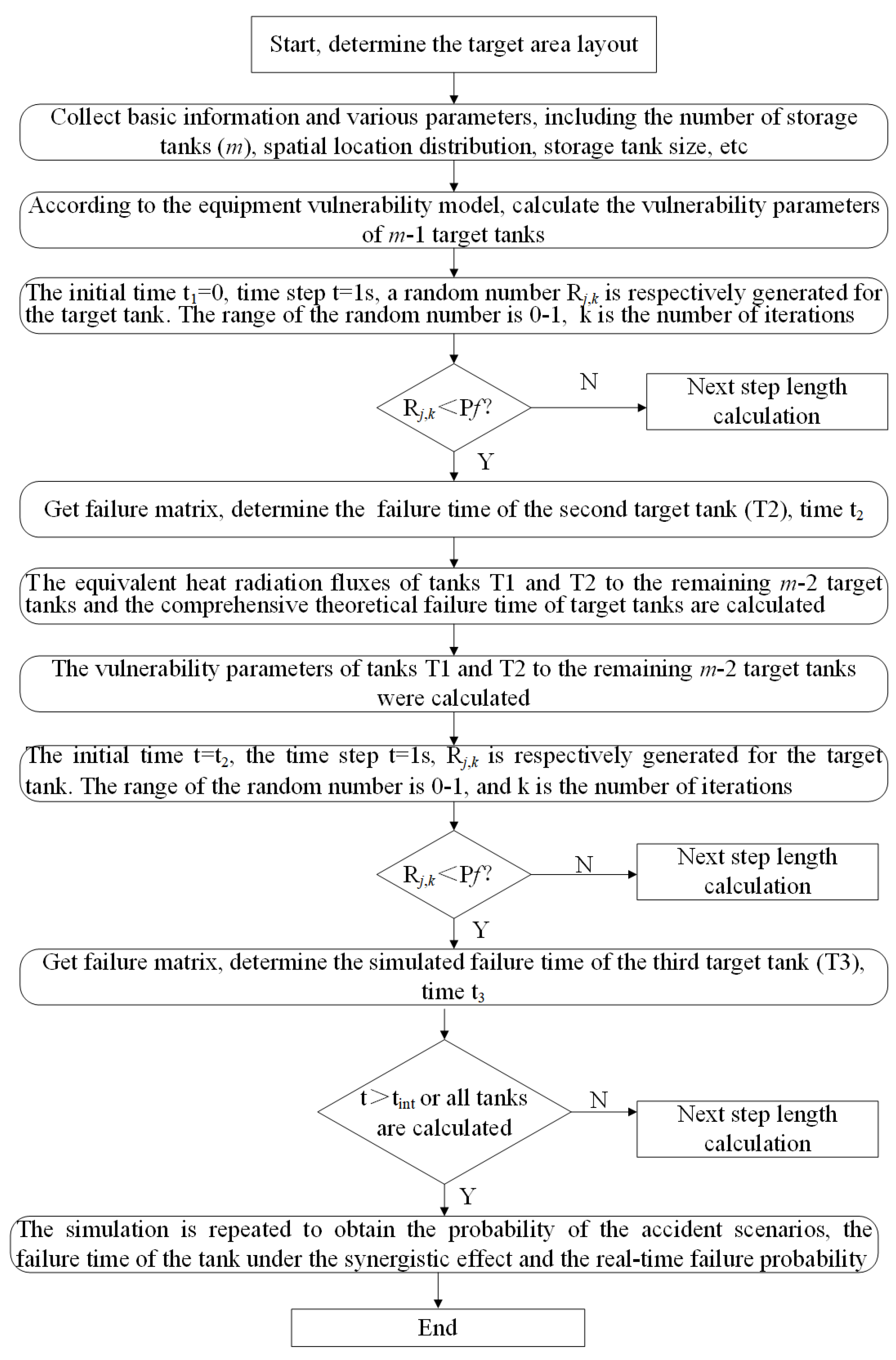
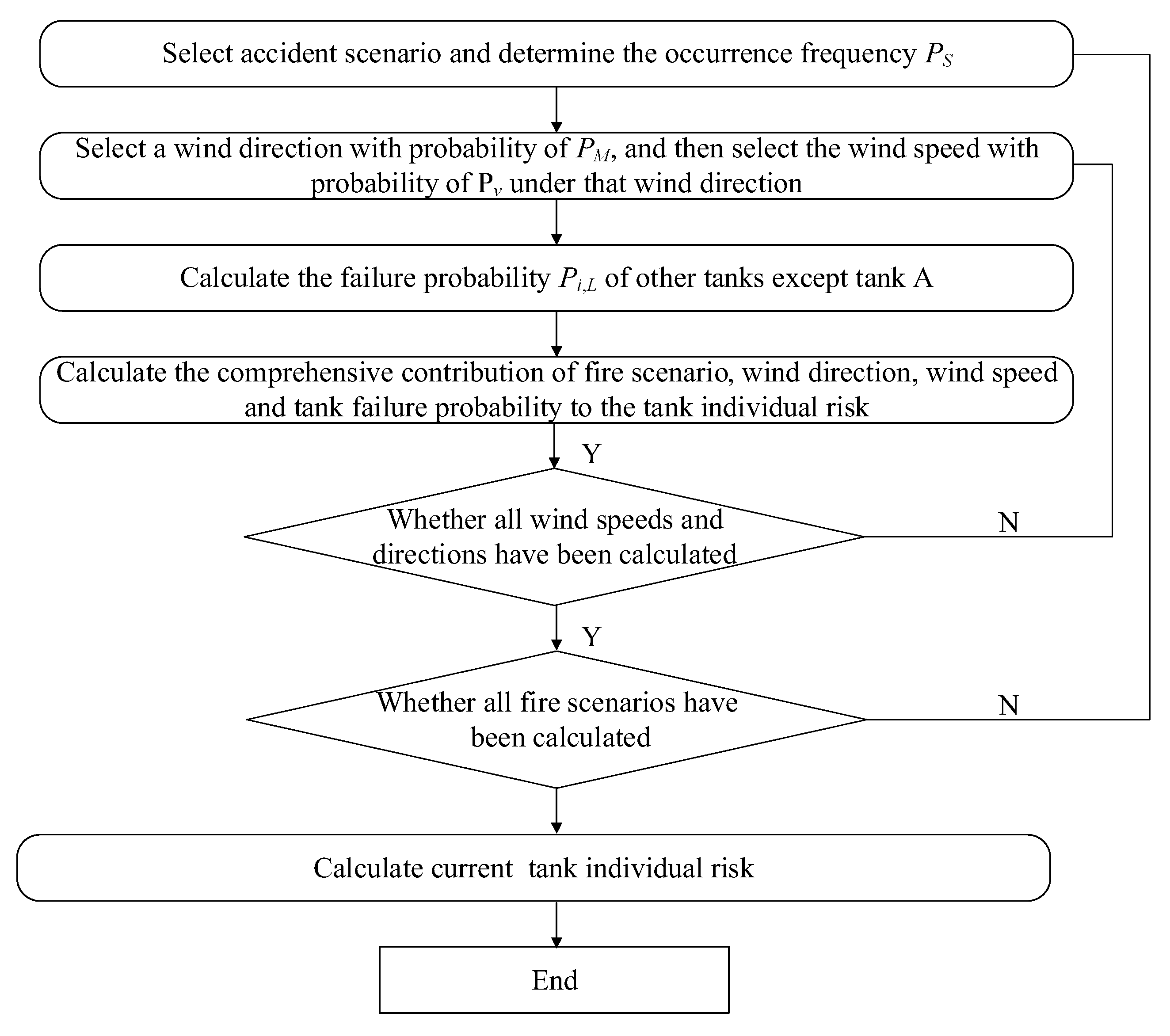


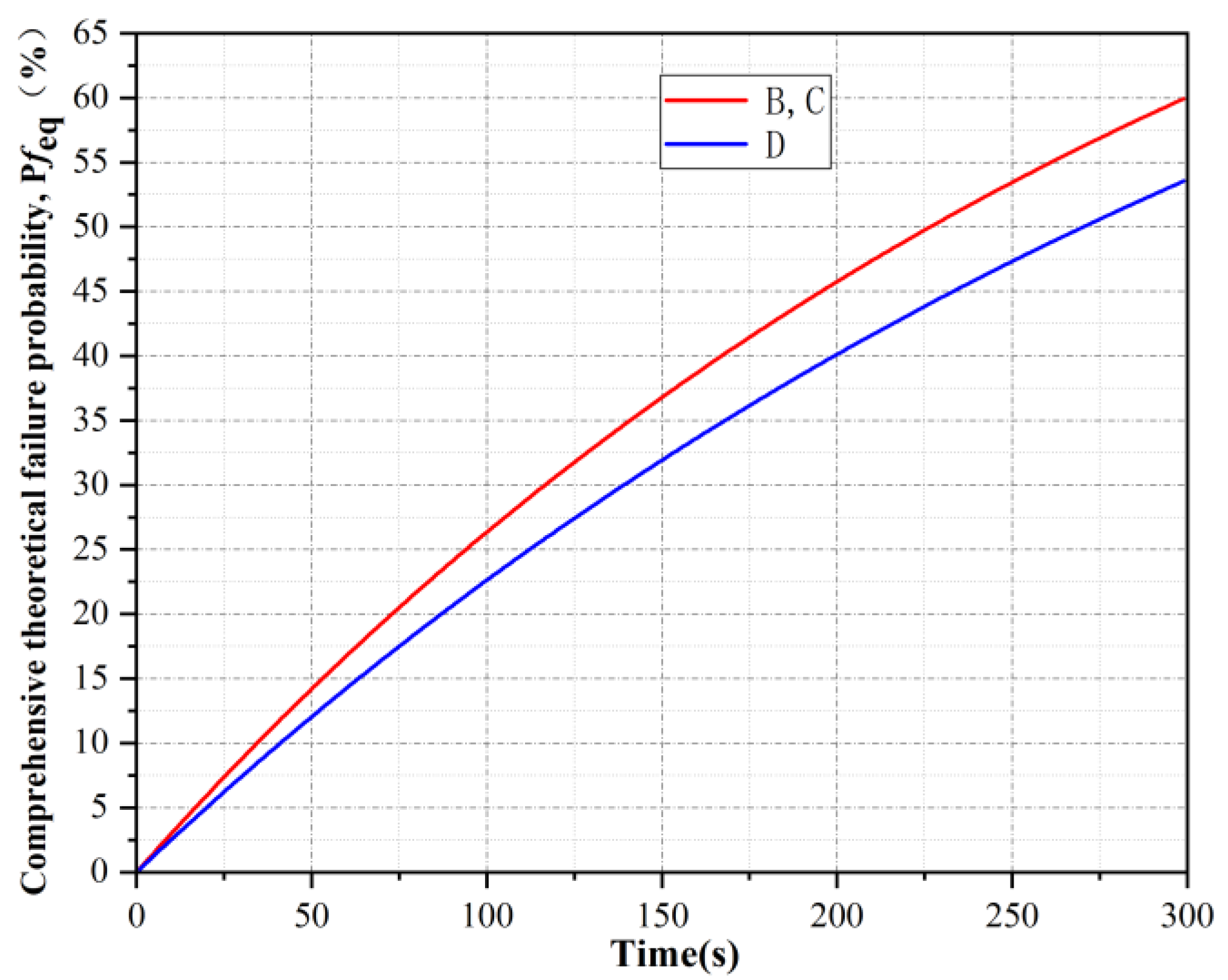
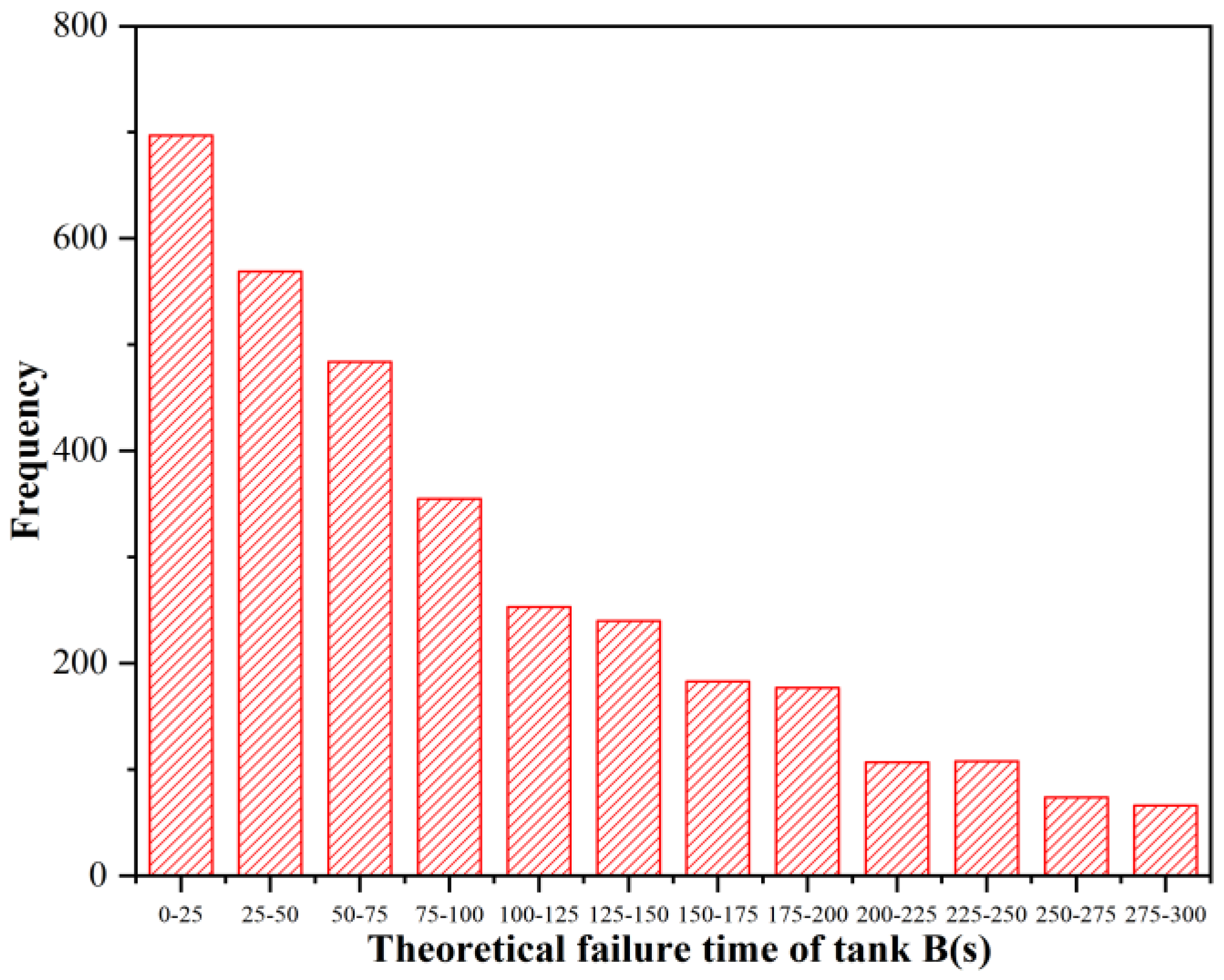

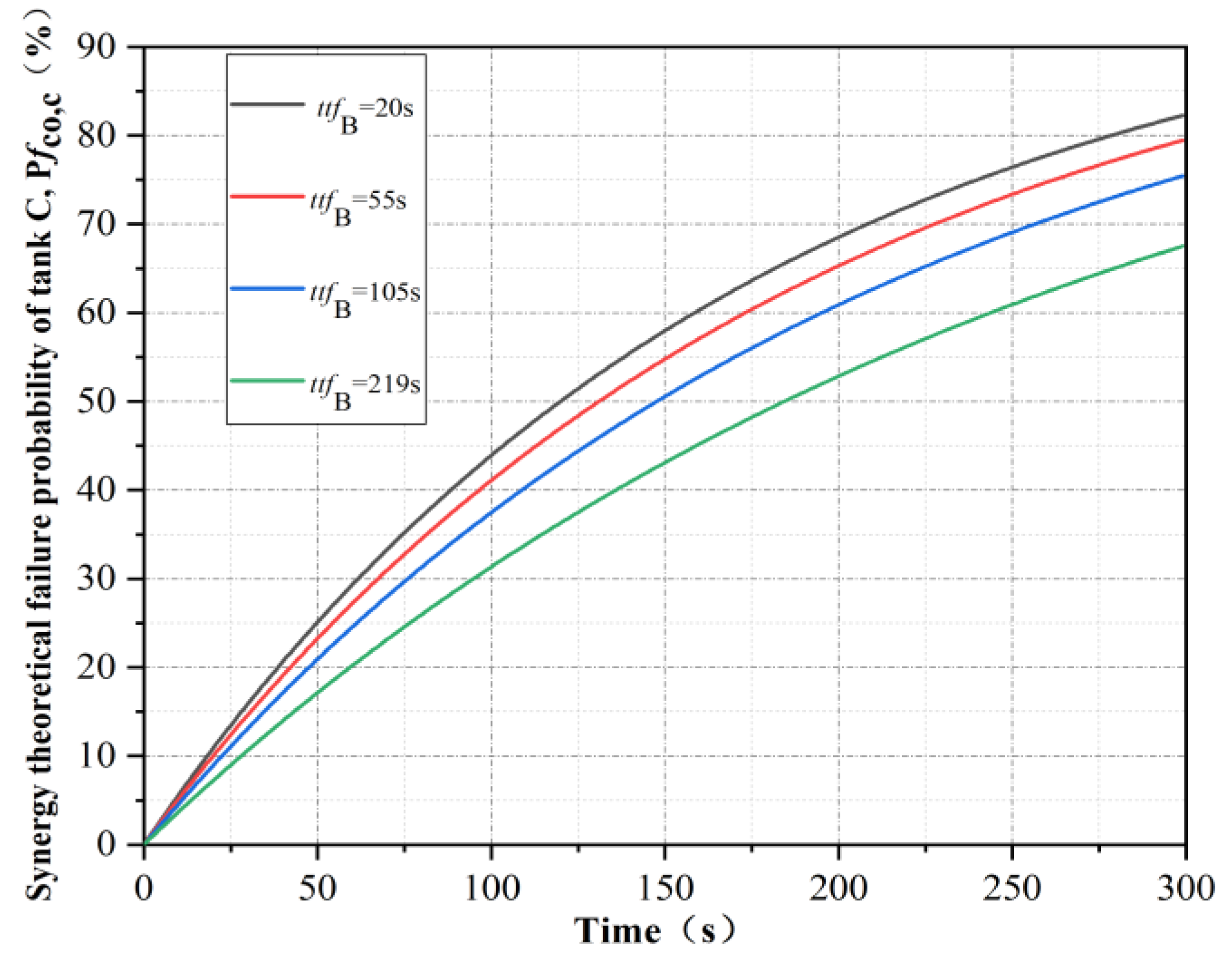

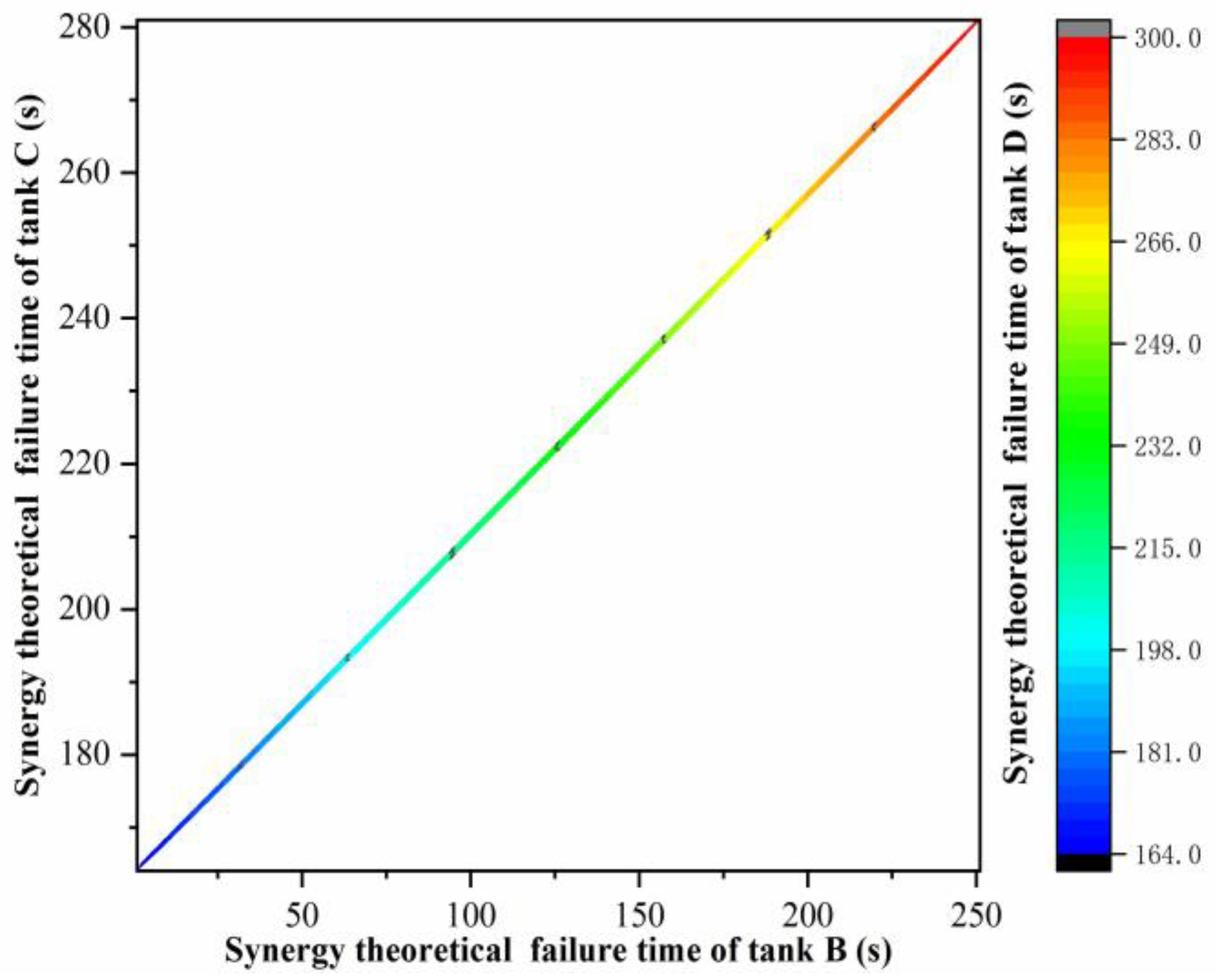


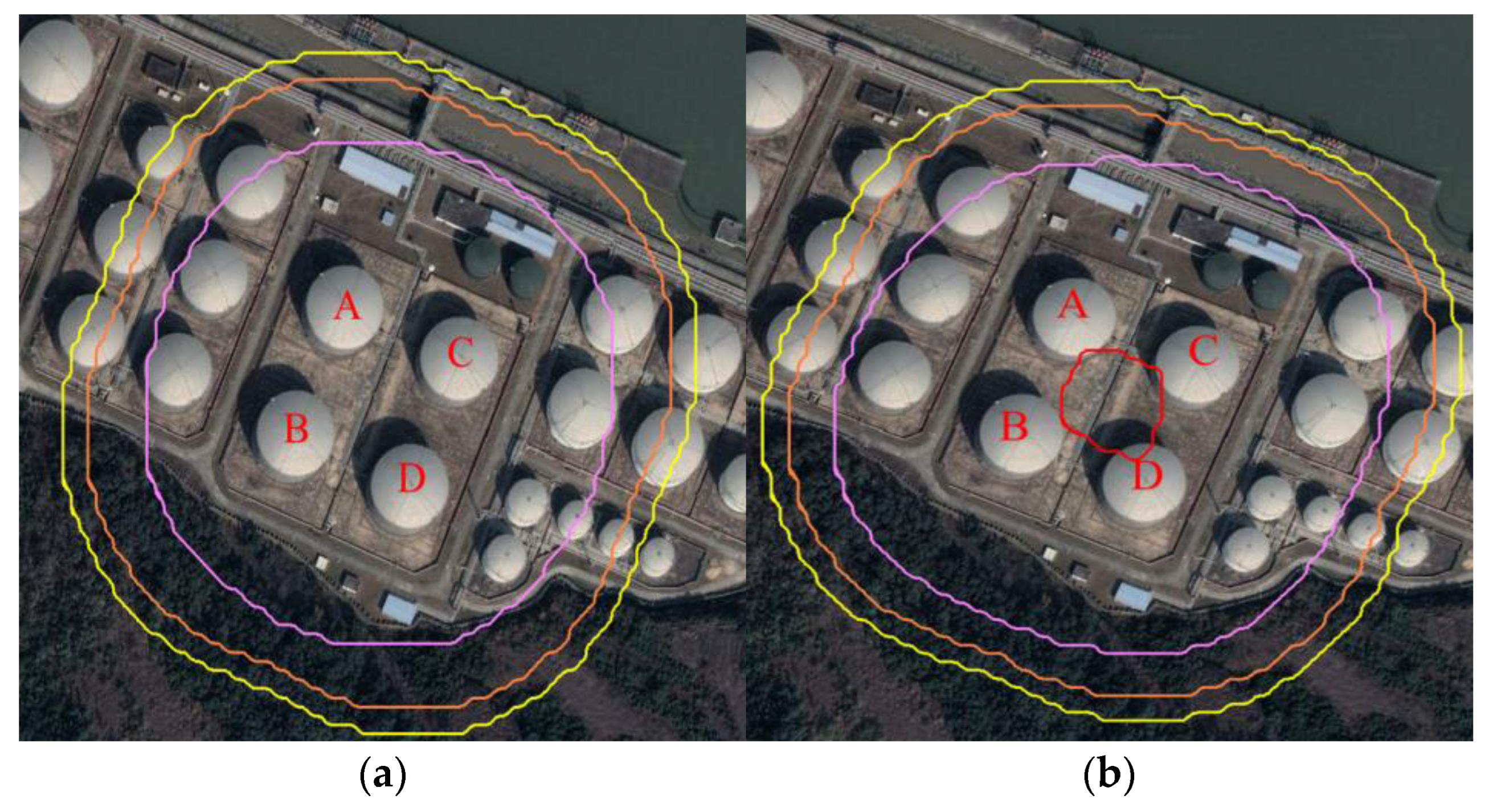
| Number | T1 | T2 | T3 | T4 | Number | T1 | T2 | T3 | T4 |
|---|---|---|---|---|---|---|---|---|---|
| 1 | A | B | C | D | 9 | A | C | D | |
| 2 | A | B | C | 10 | A | C | |||
| 3 | A | B | D | C | 11 | A | D | B | C |
| 4 | A | B | D | 12 | A | D | B | ||
| 5 | A | B | 13 | A | D | C | B | ||
| 6 | A | C | B | D | 14 | A | D | C | |
| 7 | A | C | B | 15 | A | D | |||
| 8 | A | C | D | B | 16 | A |
| Failure Time of Tank B (s) | Synergy Theoretical Failure Time of Tank C (ttfco,C) | Synergy Theoretical Failure Time of Tank D (ttfco,D) |
|---|---|---|
| 20 | 173 | 175 |
| 55 | 189 | 194 |
| 105 | 213 | 221 |
| 219 | 266 | 283 |
| Failure Time of Tank B (s) | Synergy Theoretical Failure Time of Tank C (ttfco,C) | Synergy Theoretical Failure Time of Tank D (ttfco,D) |
|---|---|---|
| 20 | 31 | 119 |
| 62 | 195 | |
| 55 | 62 | 142 |
| 214 | 214 | |
| 105 | 107 | 175 |
| 138 | 186 |
| Tank | Failure Mode | Type of Accident | Base Leakage Frequency | Failure Probability Due to Synergetic Effect | Total Failure Probability |
|---|---|---|---|---|---|
| A | Break up completely | Pool fire | 0.00002 | 0 | 0.00002 |
| B | 0.00002 | 0.00001439 | 0.00003439 | ||
| C | 0.00002 | 0.00001425 | 0.00003425 | ||
| D | 0.00002 | 0.00001365 | 0.00003365 |
Publisher’s Note: MDPI stays neutral with regard to jurisdictional claims in published maps and institutional affiliations. |
© 2022 by the authors. Licensee MDPI, Basel, Switzerland. This article is an open access article distributed under the terms and conditions of the Creative Commons Attribution (CC BY) license (https://creativecommons.org/licenses/by/4.0/).
Share and Cite
Su, M.; Wei, L.; Zhou, S.; Yang, G.; Wang, R.; Duo, Y.; Chen, S.; Sun, M.; Li, J.; Kong, X. Study on Dynamic Probability and Quantitative Risk Calculation Method of Domino Accident in Pool Fire in Chemical Storage Tank Area. Int. J. Environ. Res. Public Health 2022, 19, 16483. https://doi.org/10.3390/ijerph192416483
Su M, Wei L, Zhou S, Yang G, Wang R, Duo Y, Chen S, Sun M, Li J, Kong X. Study on Dynamic Probability and Quantitative Risk Calculation Method of Domino Accident in Pool Fire in Chemical Storage Tank Area. International Journal of Environmental Research and Public Health. 2022; 19(24):16483. https://doi.org/10.3390/ijerph192416483
Chicago/Turabian StyleSu, Mingqing, Lijun Wei, Shennan Zhou, Guoliang Yang, Rujun Wang, Yingquan Duo, Sining Chen, Mingliang Sun, Jiahang Li, and Xiangbei Kong. 2022. "Study on Dynamic Probability and Quantitative Risk Calculation Method of Domino Accident in Pool Fire in Chemical Storage Tank Area" International Journal of Environmental Research and Public Health 19, no. 24: 16483. https://doi.org/10.3390/ijerph192416483




